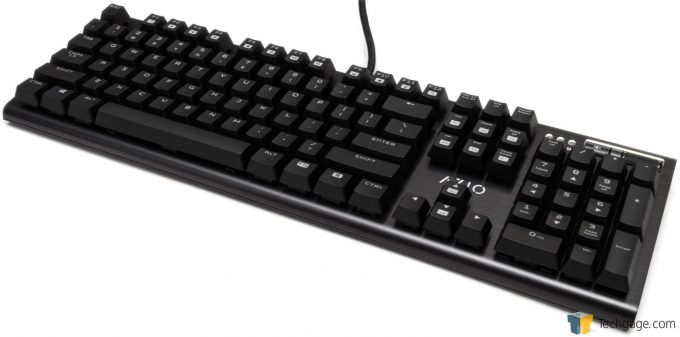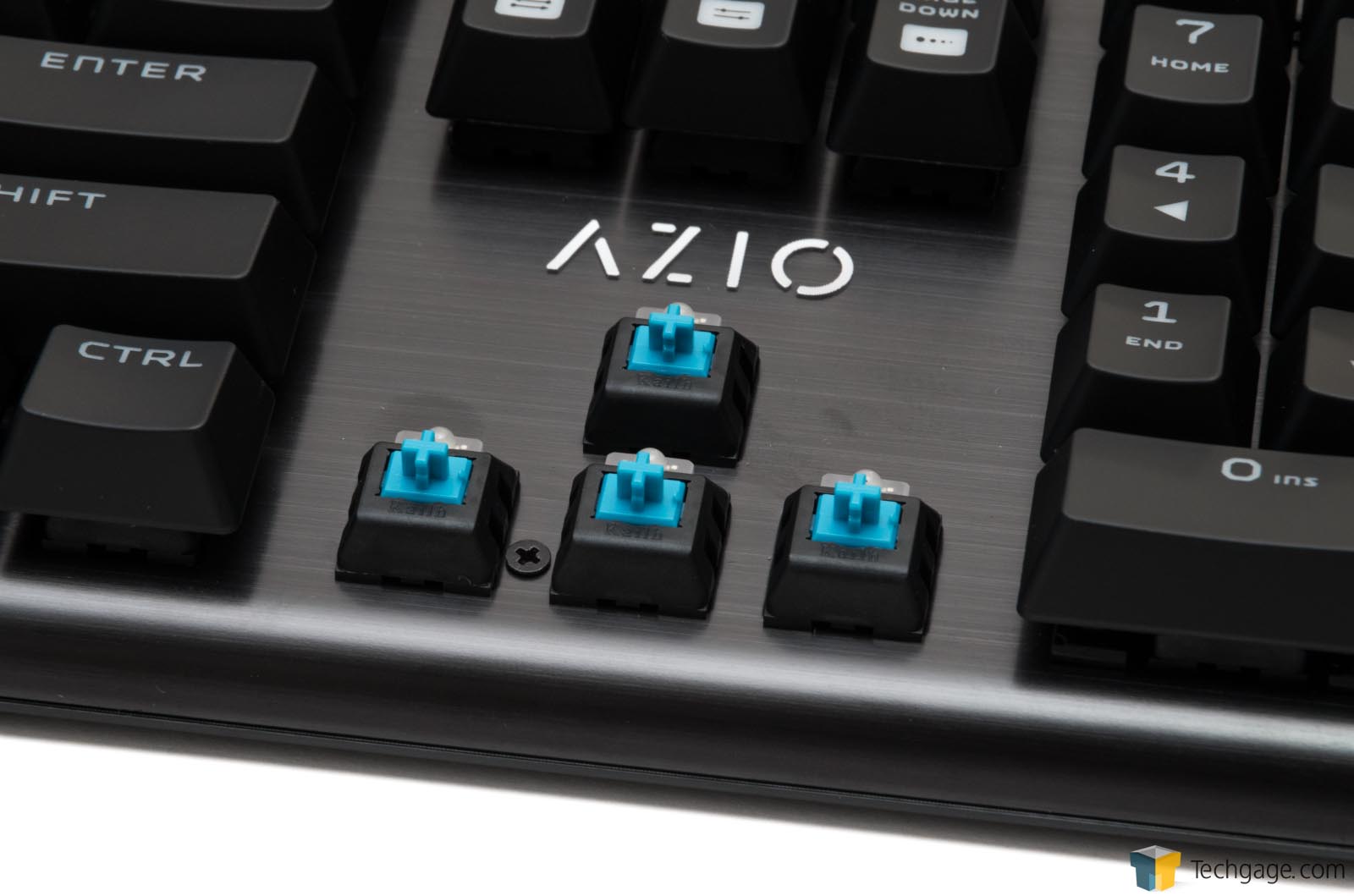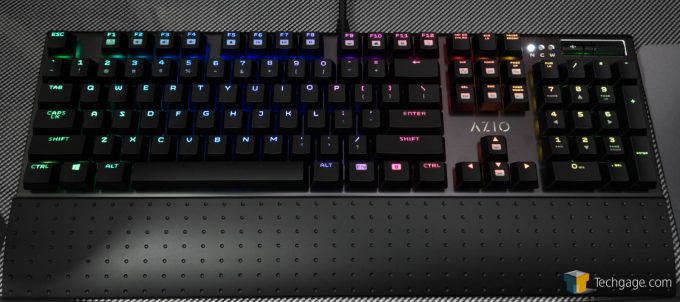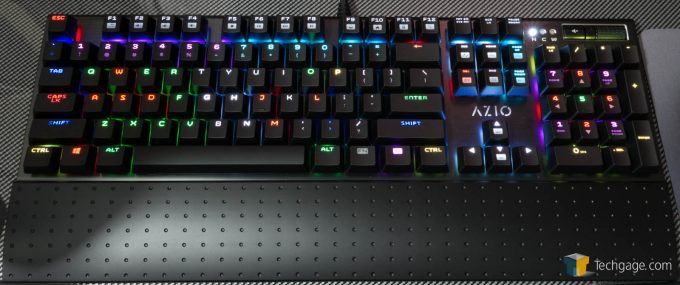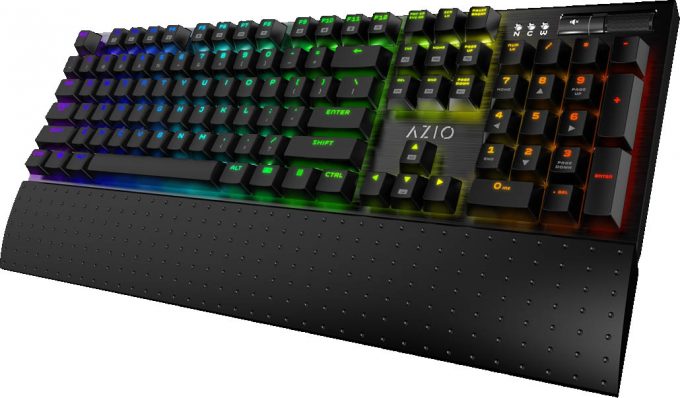- Qualcomm Launches Snapdragon 4 Gen 2 Mobile Platform
- AMD Launches Ryzen PRO 7000 Series Mobile & Desktop Platform
- Intel Launches Sleek Single-Slot Arc Pro A60 Workstation Graphics Card
- NVIDIA Announces Latest Ada Lovelace Additions: GeForce RTX 4060 Ti & RTX 4060
- Maxon Redshift With AMD Radeon GPU Rendering Support Now Available
AZIO MGK1 RGB Backlit Mechanical Gaming Keyboard Review

Looking for a no-nonsense mechanical keyboard with full RGB backlighting, but without the annoying software to go with it? AZIO has you covered with the MGK1 RGB gaming keyboard. Kailh Blue switches and a smart design keeps this keyboard solid, as we find out in this review.
Keyboards really have had a resurgence in the last few years. It still floors me how so many different varieties have cropped up, with continued pace and improvements. The mechanical craze is still in full swing with a variety of formats, sizes and switch types. More recently, it’s been a case of adding RGB backlighting to, well, pretty much everything.
AZIO has been making keyboards for a couple of years, but has joined the RGB craze as well with an update to one of its existing keyboards, the MGK1, with the MGK1 RGB. The keyboard is on the budget side (for a mechanical anyway), as it uses Kailh blue switches instead of the more standard CHERRY MX series.
I will say again like I’ve said in other reviews, it’s very hard to tell the difference between the two unless you have them side by side. The only real indicator is that of consistency in the force required to depress the key can be slightly irregular with the Kailh switches.
However, budget doesn’t mean ‘cheap’ or bad. AZIO’s MGK1 and by extension, the MGK1 RGB are solid keyboards in more ways than one. While the keyboard is marked as a gaming peripheral, it is missing the usual software stack, oddly enough, much to my delight. So there is no macro support, but it also means there is no annoying user interface to screw up your PC either.
To give you a quick rundown of the keyboard, feel free to flick through the image slider.
The Hardware
The main body of the MGK1 RGB is plastic with an aluminum faceplate. The switches are the floating style rather than recessed, which does make the whole keyboard much easier to clean. The lettering is laser-etched and top aligned so that the LED backlight shines through the lettering directly. In addition, the number/symbol keys are reversed, so the number is on top, rather than the symbol (this is to allow the backlight to shine through the number).
All keys have the standard anti-slip coating, which does make them a bit of a fingerprint magnet, but nothing a quick wipe can’t clean. The top row of Function keys also double up as media control keys, such as the standard assortment for media playback, as well as default app launchers for email, web browser, calculator and search (redundant on modern operating systems, as the Start button works the same).
In the top right corner of the board is the very useful volume control roller and mute button, a combination that’s been favored on the likes of most Corsair boards. The Num and Caps-lock indicators are a very bright white LED, which can be distracting.
The only issue with the indicators is that the third light is not for the scroll lock, but to indicate the lighting mode selection, which we’ll get into in a bit. In fact, there is no visible way to tell if Scroll Lock is enabled at all (the function may be deprecated, but I personally use Scroll Lock as the hotkey for recording video/streaming, since the light shows when things are ‘live’).
The usual N-Key rollover is in effect, so you can mash any combination of keys without those keys being lost to the USB bus, useful when some badly designed game needs you to press all three modifier keys, space, forward left + E and a number at the same time as using the numpad.
The included palm rest attaches via a central plastic clip. It’s solid plastic with no rubber (except the feet), and has small indents which can leave impressions on your hands. It works, but is nothing special.
The Kailh blue switches are much like CHERRY MX Blue in that they have a tactile response and prominent click. The key caps are also standard MX series crosses, so pretty much any type of custom key can be used. A ring-style key puller is included should you wish to either replace keys or add O-ring dampeners.
However, there are two additional ‘features’ of the MGK1 RGB that are worth mentioning before moving on to the backlight. The first is the braided cable, that while being very thick, is extremely flexible. After using a number of keyboards with such excessively thick cables, coming across one that can actually be routed through the desk is a nice change.
The other interesting feature is something that is often overlooked on a number of keyboards, and that’s the rubber feet. I don’t know what sorcery AZIO used, but the rubber (synthetic hybrid silicone? I have no idea) pads that keep the keyboard firmly planted on the desk, are like glue. With most keyboards, there is a certain amount of drift that occurs over the hours in engaging gaming sessions. This AZIO board does not budge at all. In fact, if I push the keyboard at all, the desk will give first. Yet, if you lift the keyboard up, it peels away easily for repositioning.
Custom Backlight
With most of the hardware out-of-the-way, we’ll get to big selling point, per-key backlight customization without a software stack. I’ll let it be known now, it’s a thing of beauty. While it lacks a lot of the fine-tuned fidelity with a dedicated software stack, it’s perfectly serviceable.
There are six lighting modes in total. Total keyboard transitional fading as it cycles through the full color spectrum. There is a multi-colored pulsing effect that spreads out from the center at regular intervals. The third is a slow fade from one side to the other with optional direction control. Fourth is the classic full spectrum transition from one side to the other, again with direction control. Fifth is individual key highlighting on typing that slowly fades after a couple of seconds.
The last mode is individual key customization. This allows you to cycle each key through 7 different preset colors, including red, yellow, green, cyan, blue, purple and white. The layout can be quite striking. The only complaint someone might have is a lack of certain colors like orange or pink, plus you can’t have different profiles either (which is understandable, since there are no macros either, so little need for per-game backlight control).
Brightness can be adjusted using the FN and up/down arrow keys, but this is for the entire board, and can not be adjusted per key. A small inconvenience if there was one, but perfectly acceptable.
Final Thoughts
AZIO’s MGK1 RGB is certainly a contender in a rather crowded market by now. It’s priced competitively, works flawlessly; there is just so little to fault with the keyboard. The Kailh blue switches are clicky with decent feedback. The build is solid with no give in noticeable areas. It’s quite light as far as many keyboards goes, but those super-sticky feet keep it locked down to the desk.
Playing around with the backlighting does let you become somewhat creative. While you don’t get the full choice of colors, the lack of a software requirement does make the board pure plug and play. All too often the software stack just gets in the way with bloated graphics and gaudy user interface. With everything in hardware, there is little to go wrong.
The price fluctuates between $90 to $100, so keep an eye on it if you’re interested. The MGK1 RGB is a well-built keyboard and definitely worth considering if you’re not in the market for macros and per-game profiles.
Support our efforts! With ad revenue at an all-time low for written websites, we're relying more than ever on reader support to help us continue putting so much effort into this type of content. You can support us by becoming a Patron, or by using our Amazon shopping affiliate links listed through our articles. Thanks for your support!




